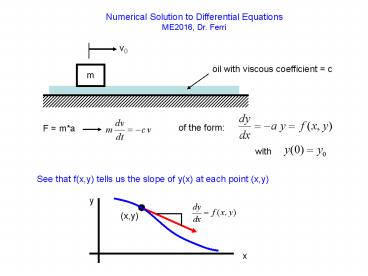Numerical Solution to Differential Equations PowerPoint PPT Presentation
1 / 29
Title: Numerical Solution to Differential Equations
1
Numerical Solution to Differential
Equations ME2016, Dr. Ferri
v0
oil with viscous coefficient c
m
of the form
F ma
with
See that f(x,y) tells us the slope of y(x) at
each point (x,y)
y
(x,y)
x
2
Vector Field for
Exact soln., y0 6
Exact soln., y0 4
Exact soln., y0 2
3
Taylor Series Analysis
v0
oil with viscous coefficient c
m
F ma
of the form
with
Could expand y(x) in a Taylor series
or
4
In general, letting
and
1st-order Euler Integration? drop higher-order
terms
More-accurate algorithms can be developed, based
on keeping more and more terms in the Taylor
series.
5
Alternate Approach
v0
oil with viscous coefficient c
m
of the form
F ma
with
Integrate over small time interval, h
6
In general,
The problem is that we dont know y(x), so
evaluating the integral is not trivial.
Could assume that if h is small enough, f(x,y)
will not change that much over the integral.
Using left-rectangular integration,
This may be recognized as 1st-order Euler
Integration. A family of improved versions are
terms Runge-Kutta methods
7
Runge-Kutta Methods
1st-order Euler prediction
y
yi
true solution
h
x
xi
xi1 xi h
Tuncation error
true solution
8
Runge-Kutta Methods
1st-order Euler prediction yi1
y
yi
true solution
fi
h
x
xi
xi1 xi h
Various RK methods differ in how they estimate fi
For 1st-order Euler integration, fi f(xi, yi)
9
2nd-order RK
y
yi
fi
h
average of two slopes
x
xi
xi1 xi h
Error is lower than Euler, but now there are 2
calls to f(x,y) required per step
Tuncation error
true solution
10
2nd-order RK Algorithm
predictor
corrector
11
Huens Method
predictor
iteration
corrector
12
4th-order RK
weighted average
where
different estimates of slope
13
ERRORS
Local (single-step)
Global (multi-step)
function evals per step
RK
1st-order
1
O(h2)
O(h) O(1/n)
2nd-order
O(h3)
O(h2) O(1/n2)
2
4th-order
O(h5)
O(h4) O(1/n4)
4
local error
For n steps,
Therefore, global error
Order of global error is 1 less than order of
local error
14
A fair comparison between two RK methods must
account the differing number of function calls
per step
RK1 (Euler-integration)- - 1 function call per
step
x0
x1
x2
x3
x4
x5
x8
x6
x7
RK4 - - 4 function calls per step
x0
x1
x2
Example integrate from 0 to 4 using n400
function evaluations
1st-order Euler with h 0.01 global error
O(0.01)
4th-order RK with h 0.04 global error
O(0.00000256)
104 times less error for same amount of work ?
FREE LUNCH !!!
15
Example 1st-order Euler applied to Oil Problem
v0
oil with viscous coefficient c
m
F ma
of the form
a1 v0 2 h0.1 n 10 yi v0 Y(1)
yi xi0 X(1)xi for i 1n xi (i-1)h
fi -ayi phi_i fi yip1 yi
phi_ih xip1 xi h Y(i1)yip1
X(i1)xip1 yi yip1 end
plot(X,Y,'o-',X,v0exp(-aX),'r-') xlabel('Time')
ylabel('Speed') legend('Euler, h 0.1','Exact')
Note The only difference for other RK schemes
is in the definition of phi_i
16
(No Transcript)
17
1st-order Euler Method Detail of comparison of h
0.1 with h 0.05
See that halving h cuts the error in half
(approximately)
18
Example, 2nd-order RK
By inspection,
with initial condition
Exact solution
xv00.17 yvexp(-0.5xv.2) x0 y1 h0.5
Xx Yy xf6.5 while xltxf y0y(-xy)h
yy(h/2)((-xy) (-(xh)y0)) xxh XX
x YY y end
exact
plot(X,Y,'o-',xv,yv,'r-') xlabel('x')
ylabel('y') legend('2nd-order RK','Exact') title('
h 0.5')
19
The numerical algorithm is unstable because h is
too large !
20
Reducing h to 0.2 gives a stable, accurate
algorithm
21
Higher-order systems of equations
Predator-prey example let y1 the number of
rabbits
let y2 the number of foxes
Governing equations
,
or
In vector form
1st-order Euler
22
Create a m-file function pprey.m
function yprime pprey(t,y) a 1.2 b0.6
c0.8 d0.3 yprime(1)ay(1)-by(1)y(2) yprim
e(2)-cy(2)dy(1)y(2) yprimeyprime()
h0.001 n 30000 yi 2 1 Y(,1)
yi ti0 T(1)ti for i 1n ti (i-1)h
fi pprey(ti,yi) yip1 yi fih tip1
ti h Y(,i1)yip1 T(i1)tip1 yi
yip1 end plot(T,Y(1,),'-',T,Y(2,),'--') xlab
el('Time') ylabel('Population') legend('Rabbits',
'Foxes')
vv() just makes v a column vector
23
(No Transcript)
24
Can also generate a phase plot of foxes vs
rabbits
25
Built-in Matlab RK Programs
Vector of initial conditions
Timespan t0 tf
String containing the name of the m-file that
calculates yprime
t,y ode45('pprey',0 30,2 1)
time
Matlab function for 4th and 5th-order RK
Matrix of response 1st-col y1, 2nd-coly2, etc
other ODE solvers ODE23, ODE113, ODE15S,
ODE23S, ODE23T, ODE23TB
26
Numerical Example Eulers Method
h0.5
Note that yi in rows 2 and below is equal to yip1
in the preceding row.
27
Numerical Example RK2
h0.5
28
Implicit Methods Trapezoidal
Recall that
Trapezoidal Approx
Methods are called implicit when yi1 occurs on
both sides of the equation
Question How do we solve for yi1 ??
Why would we want to?
Because implicit methods are generally less prone
to instability than explicit methods. In many
cases, we can prove that implicit methods are
unconditionally stable. That means that we can
take a larger time step without diverging small
time steps are only needed to achieve accuracy,
not stability.
29
In the case of first-order linear odes, implicit
technique can be easily solved for yi1
Example
Solve for yi1
lt 1
Trap.approx of
In this form, it looks like an explicit
technique, but it is unconditionally stable!

